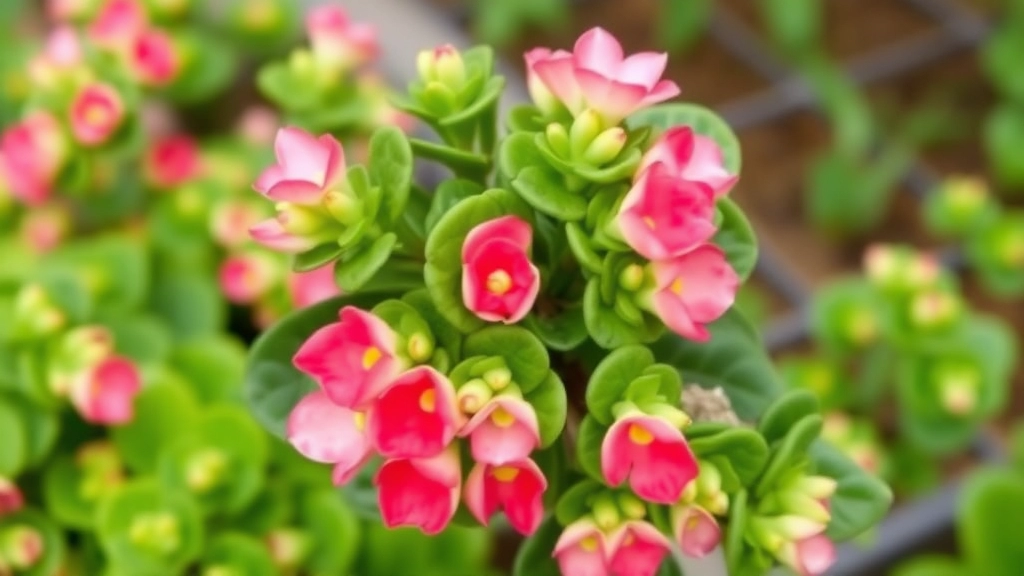Pruning Kalanchoe Plants
Pruning Kalanchoe plants is essential for maintaining their health and appearance. The best time to prune is right after the blooming period, ensuring your plants stay vibrant and well-shaped. Using sharp, clean tools is crucial to make precise cuts and prevent infections.
Steps for Pruning
Start by removing any dead or damaged leaves and stems. This not only improves the plant’s look but also encourages new growth. For shaping, trim back any leggy or overgrown branches.
Additional Tips
- Deadheading: Deadheading spent flowers can prolong blooming.
- Propagation: Pruning for propagation allows you to grow new plants from healthy cuttings.
Avoid common mistakes like over-pruning, and always follow up with proper care to help your Kalanchoe recover and thrive.
Best Time for Pruning Kalanchoe
Pruning your Kalanchoe at the right time is crucial for its health and blooming potential.
Many gardeners wonder, “When is the best time to prune my Kalanchoe?”
The ideal period for pruning is during the spring, just before the growing season begins.
This timing allows the plant to recover quickly and encourages new growth.
II. Tools Needed for Pruning Kalanchoe
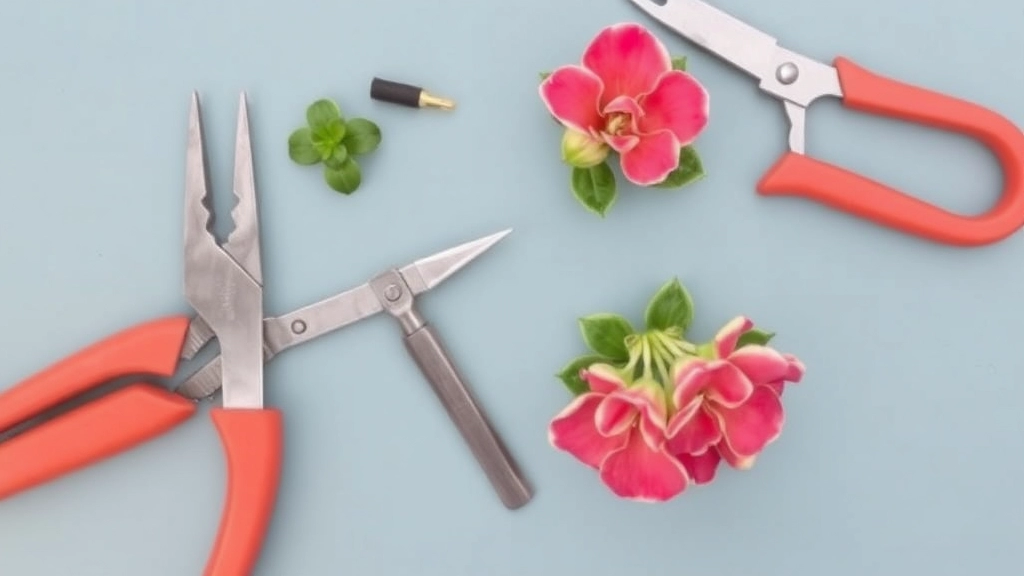
So, you’re ready to give your Kalanchoe a little trim? Great choice! But before you dive in, let’s chat about the tools you’ll need to make this process smooth and effective.
Essential Tools for Pruning
- Sharp Pruning Shears
A good pair of sharp pruning shears is non-negotiable.
Dull blades can damage the plant and make it harder to achieve clean cuts. - Gloves
Protect your hands from any sap or irritants.
Plus, it’s always good to have a barrier between you and the plant. - Disinfectant
Keep some rubbing alcohol handy.
Wipe down your shears before and after pruning to prevent disease spread. - Small Trowel
If you plan on repotting or adjusting the soil, a small trowel will come in handy. - Container for Cuttings
Have a container ready for any cuttings you want to propagate.
This keeps your workspace tidy and your cuttings safe. - Watering Can
After pruning, you’ll want to give your Kalanchoe a light drink.
Just make sure not to overdo it!
With these tools at your disposal, you’re all set to tackle your Kalanchoe pruning like a pro.
Steps to Prune Kalanchoe Plants
Pruning your Kalanchoe can feel daunting, especially if you’re unsure where to begin. However, with a few straightforward steps, you can enhance the health and appearance of your plant.
1. Gather Your Tools
Before diving into the pruning process, ensure you have the right tools on hand. You’ll need:
- Sharp scissors or pruning shears: Clean cuts promote better healing.
- Gloves: Protect your hands from any sap or irritants.
- Disinfectant: To clean your tools and prevent disease.
2. Assess Your Plant
Take a moment to observe your Kalanchoe. Look for:
- Dead or yellowing leaves: These should be removed to encourage new growth.
- Leggy stems: If your plant is stretching towards light, it may need shaping.
3. Make Your Cuts
When you’re ready to prune, follow these guidelines:
- Cut just above a leaf node: This encourages new growth from that point.
- Remove no more than one-third of the plant: This prevents shock and promotes healthy regrowth.
- Trim dead flowers: This is known as deadheading and helps the plant focus energy on new blooms.
4. Clean Up
After pruning, make sure to:
- Dispose of cuttings: This prevents pests and diseases.
- Clean your tools: Disinfect them to maintain hygiene for future use.
If you’re interested in more detailed care tips, check out our Kalanchoe Blossfeldiana leaf care guide and our complete care guide for Kalanchoe Blossfeldiana.
How to Shape Your Kalanchoe
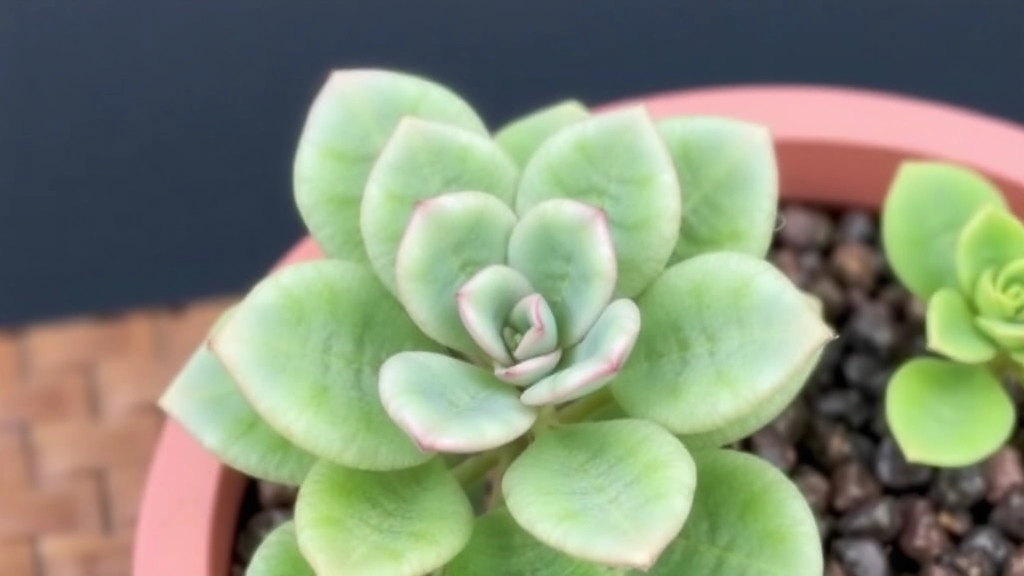
Shaping your Kalanchoe is essential for maintaining its health and enhancing its aesthetic appeal. Many plant enthusiasts often wonder how to achieve a balanced and attractive form for their plants.
To effectively shape your Kalanchoe, consider the following steps:
- Assess the Plant’s Growth: Take a moment to look at your Kalanchoe. Identify areas that are overgrown or uneven. This will help you determine where to cut.
- Select the Right Time: The best time to shape your Kalanchoe is during its active growing season, typically in spring. This ensures that the plant can recover quickly from any cuts.
- Use Clean Tools: Always use sharp, sterilised scissors or pruning shears. Clean tools prevent the spread of disease and ensure a clean cut.
- Cut Strategically: Focus on cutting back any leggy stems. Trim them back to just above a leaf node to encourage bushier growth. Aim to maintain a symmetrical shape.
- Encourage Branching: If you want a fuller plant, pinch or cut the tips of the stems. This encourages side shoots to develop, resulting in a bushier appearance.
- Regular Maintenance: Regularly check your Kalanchoe for any uneven growth. A little shaping here and there can go a long way in keeping your plant healthy and attractive.
Deadheading is an essential practice that can enhance the longevity of your Kalanchoe’s blooms. If you’re looking for more comprehensive care tips, you might find our [ultimate guide to growing and caring for succulent plant Kalanchoe](https://planthq.org/ultimate-guide-to-growing-and-caring-for-succulent-plant-kalanchoe/) particularly useful.
Deadheading involves removing spent flowers from the plant. This not only improves the plant’s appearance but also encourages new growth and prolongs the blooming period. For those interested in specific varieties, our [flowering Kalanchoe succulent care tips for growth and propagation](https://planthq.org/flowering-kalanchoe-succulent-care-tips-for-growth-propagation/) can provide additional insights.
By regularly deadheading your Kalanchoe, you can ensure it remains vibrant and blooming for a longer period.
Managing Leggy Growth in Kalanchoe
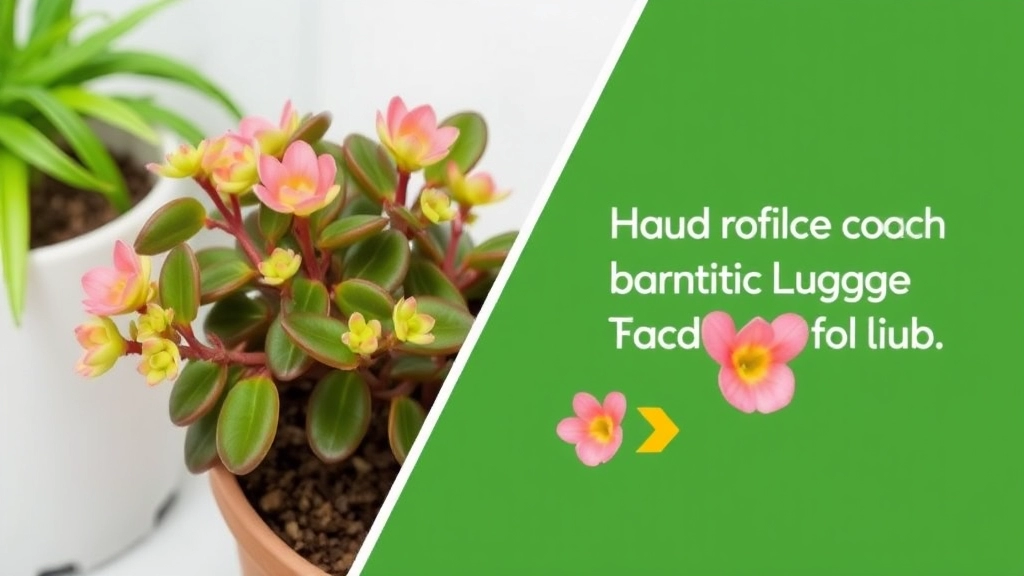
Have you noticed your Kalanchoe stretching towards the light, looking a bit too leggy? You’re not alone! This is a common issue many plant lovers face, and it’s often a sign that your plant needs a little TLC.
Why Does Leggy Growth Happen?
Leggy growth typically occurs when your Kalanchoe isn’t getting enough light. As it reaches for sunlight, the stems elongate, and the leaves may become sparse. Here’s how to tackle this problem:
- Adjust Light Conditions:
- Move your plant closer to a bright window.
- If natural light is limited, consider using grow lights.
- Prune Wisely:
- Trim back those long stems to encourage bushier growth.
- Cut just above a leaf node to promote new growth.
- Rotate Regularly:
- Turn your Kalanchoe every few weeks to ensure even light exposure.
- Repot if Necessary:
- If your plant is outgrowing its pot, consider repotting into a slightly larger container with fresh soil.
- Fertilize Sparingly:
- Use a balanced fertilizer during the growing season to support healthy growth.
By taking these steps, you can help your Kalanchoe regain its compact, vibrant shape.
When you prune your Kalanchoe, you can easily create new plants from the cuttings. This process not only enhances the appearance of your existing plant but also allows you to expand your indoor garden or share with friends. Here’s how to do it effectively:
1. **Choose Healthy Stems:** Look for healthy, robust stems that are at least a few inches long. Avoid any that show signs of disease or damage.
2. **Use Clean Tools:** Always ensure your pruning shears are clean and sharp. This prevents the spread of disease and makes cleaner cuts.
3. **Cut at an Angle:** Make a clean cut just below a leaf node at a 45-degree angle. This increases the surface area for rooting.
4. **Remove Lower Leaves:** Trim off any leaves from the bottom half of the cutting. This helps prevent rot when planted.
5. **Let Cuttings Callous:** Allow the cuttings to dry and callous over for a few hours or overnight. This step is crucial to prevent rot once they are planted.
6. **Plant in Soil:** Use a well-draining potting mix and plant the cuttings about an inch deep. Water lightly to settle the soil.
7. **Provide Proper Conditions:** Place the cuttings in a warm, bright location but out of direct sunlight. This encourages rooting without stressing the plant.
By following these steps, you can successfully propagate your Kalanchoe and enjoy a flourishing collection of plants. For more detailed guidance, you might want to check out our [Kalanchoe Tomentosa Propagation Guide](https://planthq.org/kalanchoe-tomentosa-propagation-guide-stepbystep-tips/) or learn [How to Care for a Kalanchoe Succulent](https://planthq.org/how-to-care-for-a-kalanchoe-succulent-expert-tips/).
Common Mistakes to Avoid When Pruning Kalanchoe
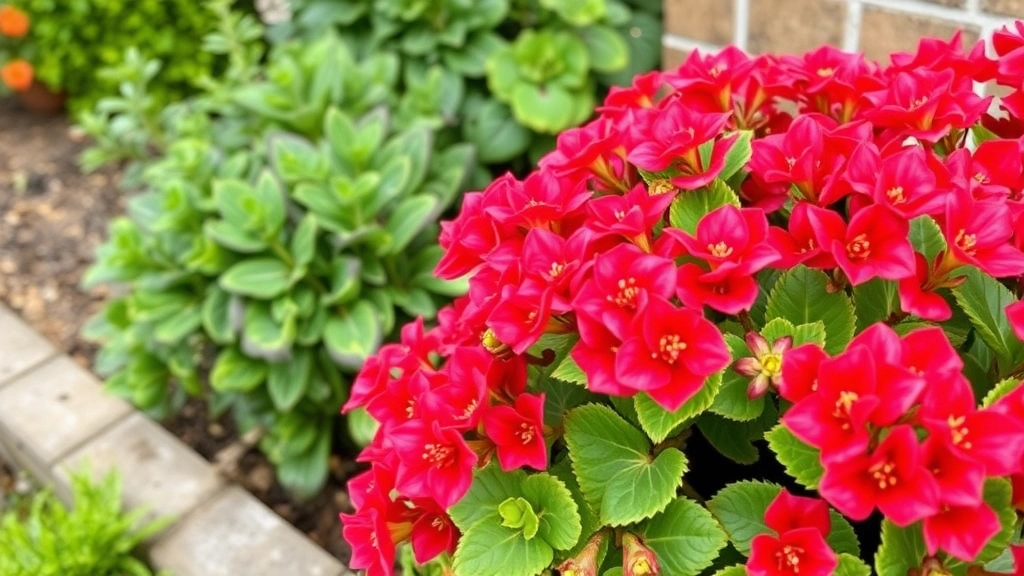
So, you’re ready to prune your Kalanchoe, but hold on! There are a few common slip-ups that can turn your good intentions into a bit of a disaster. Let’s dive into what to watch out for.
1. Pruning at the Wrong Time
Timing is everything! Pruning too early in spring can stunt growth. Wait until you see new growth before getting snippy.
2. Using Dull Tools
Ever tried cutting paper with dull scissors? It’s a hassle, right? The same goes for pruning. Always use sharp, clean tools to avoid damaging the plant.
3. Over-Pruning
Less is more! Taking off too many leaves can stress your Kalanchoe. Stick to removing about a third of the plant at most.
4. Ignoring the Plant’s Growth Habit
Kalanchoe has its own style! Understand its natural shape before you start cutting. You don’t want to turn a lovely round plant into a flat pancake.
5. Forgetting to Clean Your Tools
Bacteria loves a good party! Always disinfect your tools before and after pruning. This prevents the spread of diseases.
6. Not Paying Attention to the Leaves
Yellowing leaves? That’s a sign! Remove them to keep your plant healthy and looking fresh.
7. Skipping Post-Pruning Care
Just because you’ve pruned doesn’t mean you’re done! Give your Kalanchoe a little TLC afterward. Water it lightly and keep it in bright, indirect light.
Post-Pruning Care Tips
After pruning your Kalanchoe, you might wonder how to ensure it thrives. Proper post-pruning care is essential to help your plant recover and flourish.
FAQs on Pruning Kalanchoe Plants
What tools do I need to prune my Kalanchoe?
To prune your Kalanchoe effectively, you’ll need a few essential tools: sharp pruning shears, gloves, disinfectant, a small trowel, a container for cuttings, and a watering can. These tools will help you achieve clean cuts and maintain plant health.
When is the best time to prune my Kalanchoe?
The optimal time to prune your Kalanchoe is during its active growing season, typically in spring. This allows the plant to recover quickly from any cuts.
How can I shape my Kalanchoe?
To shape your Kalanchoe, assess its growth, use clean tools, and cut strategically. Focus on trimming leggy stems and encourage branching by pinching or cutting the tips of the stems. Regular maintenance is key to keeping your plant healthy and attractive.
Why is my Kalanchoe growing leggy?
Leggy growth often occurs due to insufficient light. To address this, adjust the light conditions by moving the plant closer to a bright window or using grow lights. Prune wisely and rotate the plant regularly to ensure even light exposure.
What are common mistakes to avoid when pruning Kalanchoe?
Common mistakes include pruning at the wrong time, using dull tools, over-pruning, ignoring the plant’s growth habit, forgetting to clean your tools, not paying attention to the leaves, and skipping post-pruning care. Avoid these pitfalls to ensure your Kalanchoe thrives.
How do I manage leggy growth in my Kalanchoe?
To manage leggy growth, adjust light conditions, prune back long stems, rotate the plant regularly, repot if necessary, and fertilize sparingly. These steps will help your Kalanchoe regain its compact, vibrant shape.
What should I do after pruning my Kalanchoe?
After pruning, give your Kalanchoe a light watering and place it in bright, indirect light. This post-pruning care helps the plant recover and continue to grow healthily.
References
-
Gardening Know How – Pruning Kalanchoe Plants
-
The Spruce – How to Prune a Kalanchoe Plant
-
Better Homes & Gardens – Pruning Kalanchoe
